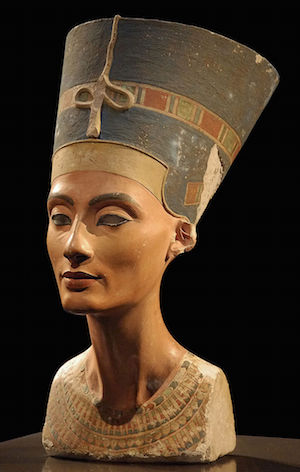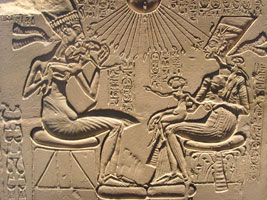Akhenaten was the second son of Amenhotep III and his Great Wife, Tiy. Tiy was a strong character who retained a great deal of influence with her son throughout his reign. His elder brother, crown prince Tuthmosis, was the King’s eldest son, High Priest of Ptah at Memphis, Sem-Priest of Ptah at Memphis, and Overseer of the Prophets of Upper and Lower Egypt. He would have been pharaoh, but seems to have died shortly before Amenhotep III’s sed festival in the thirtieth year of his reign.
Akhenaten also had a number of sisters, such as Princesses Sitamun, Iset, Henuttaneb, Nebetiah, and Beketaten. Both Sitamun and Isis became the great royal wives of their father Amenhotep III in the later years of his reign.

Ahmed Osman has suggested that Akhenaten was Moses and that his maternal grandfather Yuya was the same person as the Biblical Joseph. However, it is known that Yuya’s family were part of the regional nobility of Akhmin, in upper (southern) Egypt, and there is no evidence to support the rather unlikely suggestion that he was an Israelite. Osman also notes that “Aten” is similar to “Adon” (a Hebrew term for god), but the Israelites used the terms “Yahweh” and “Elohim” to represent their god, so this may be a red herring.

Akhenaten’s Great Wife was Nefertiti, famous in part because of the beautiful bust of her found at Amarna (and now on display in Berlin). Her parentage is uncertain. Tey (the wife of Ay) was her wet nurse, but it does not automatically follow that she was part of her family.
Akhenaten was regularly depicted with his family, playing with his children and kissing his wife, as well as more formal ceremonial situations. Nefertiti often appeared beside the king in actions usually reserved for a Pharaoh, suggesting that she attained unusual power for a queen. Some suggest that she was disgraced because her name was replaced in several instances by that of her daughter Merytaten, who succeeded her as “Great Royal Wife”, but it is equally likely that she died and was buried with all due ceremony. Some scholars have suggested that she acted as co-regent for part of Akhenaten’s reign, while others suggest that his successor Smenkhare was actually Nefertiti dressed as a man. It is even suggested that Nefertiti was the male lover of Akhenaten who was also known as Smenkhare!
This is partly because they both used the name “Neferneferuaten” (“the beautiful beauty of the Aten”) and Nefertiti “disappeared” around the time that Smenkhare is first mentioned. To confuse the issue further, Smenkhare was apparently buried in the position generally associated with a female (if it is is indeed he who is buried in KV55). However, romantic depictions of Smenkhare with Merytaten (daughter of Akhenaten and Nefertiti) do not lend much weight to suggestions that he was either a woman in drag or the gay lover of the king.

Akhenaten and Nefertiti apparently had six daughters; Merytaten, Mekytaten, Ankhesenpaaten (who became Ankhesenamun), Neferneferuaten-ta-sherit, Neferneferure, and Sotepenre. However, proponents of the theory that Nefertiti was male note that Akhenaten had a number of other wives, including Kiya and possibly Tadukhipa (the daughter of Tushratta, King of Mitanni who married Amenhotep III during the last few years of his reign) and a royal concubine called Py (or Ipy). Queen Kiya is often considered to be the mother of Smenkhare and Tutankhamun, and some argue that she was one and the same as Tadukhipa, while others suggest that Nefertiti was the Egyptian name given to Tadukhipa on her arrival in Egypt. When Nefertiti “disappeared” around the twelfth year of Akhenaten’s reign, Kiya rose to prominence. Akhenaten also seems to have married three of his daughters, Merytaten, Ankhesenpaaten and Mekytaten.

Many scholars have argued that he was strongly influenced by his mother, Tiy, or Nefertiti, even in the decision to abandon the gods and build a new capital. One theory suggests that Nefertiti was the biblical Jezebel, the wife of King Ahab, and that she brought the new religion with her. Others suggest that it was in fact Queen Tiy who influenced the young king. She had a barge called “Aten-tjehen” (“the Aten gleams” or “the dazzling Aten”) and the towards the end of the reign of Akhenaten’s father, Amenhotep III, the Aten was depicted increasingly often.
It is even suggested by some that Akhenaten was in love with his mother. Velikovsky went as far as to suggest that Akhenaten was the historical figure behind the story of Oedipus! He suggested that Akhenaten had elephantiasis, producing enlarged legs, and notes that Oedipus is Greek for “swollen feet”. Proponents of this (rather outlandish) view suggest that Kiya was a foreign princess who encouraged her smitten son to introduce the cult of the Aten, and that he destroyed the temples of Amun because he hated his father.
Bibliography
- Dijk, Jacobus Van (2000) “The Amarna Period and the later New Kingdom”, in The Oxford History of Ancient Egypt Ed I. Shaw
- Dodson, A and Hilton, D. (2004) The Complete Royal Families of Ancient Egypt
- Fletcher, Joann (2004) The search for Nefertiti
- Kemp, Barry (2015) The City of Akhenaten and Nefertiti, Amarna and its people
- Tyldesley, Joyce (1998) Nefertiti
- Wilkinson, Toby (2010) The Rise and Fall of Ancient Egypt
copyright J Hill 2010